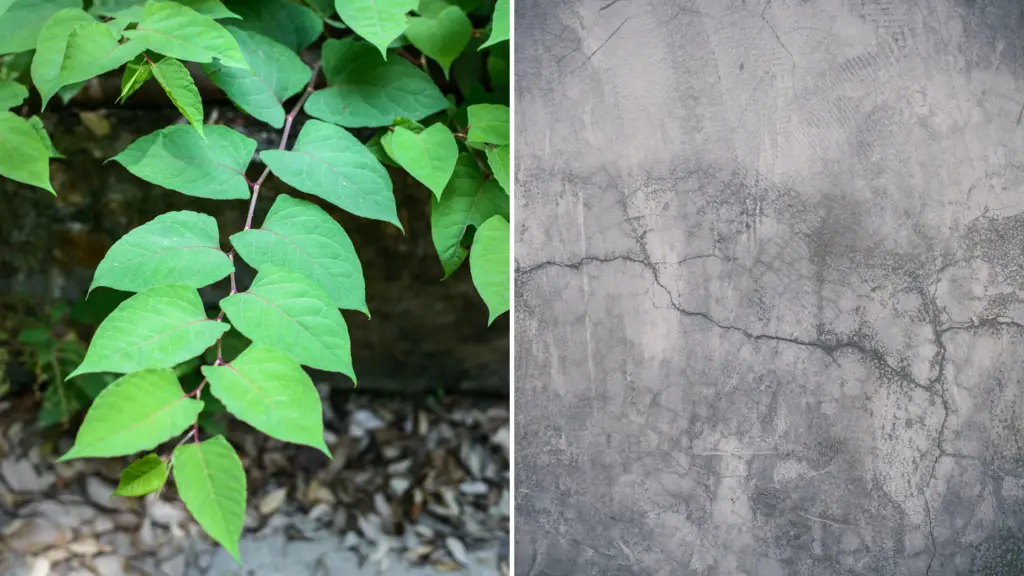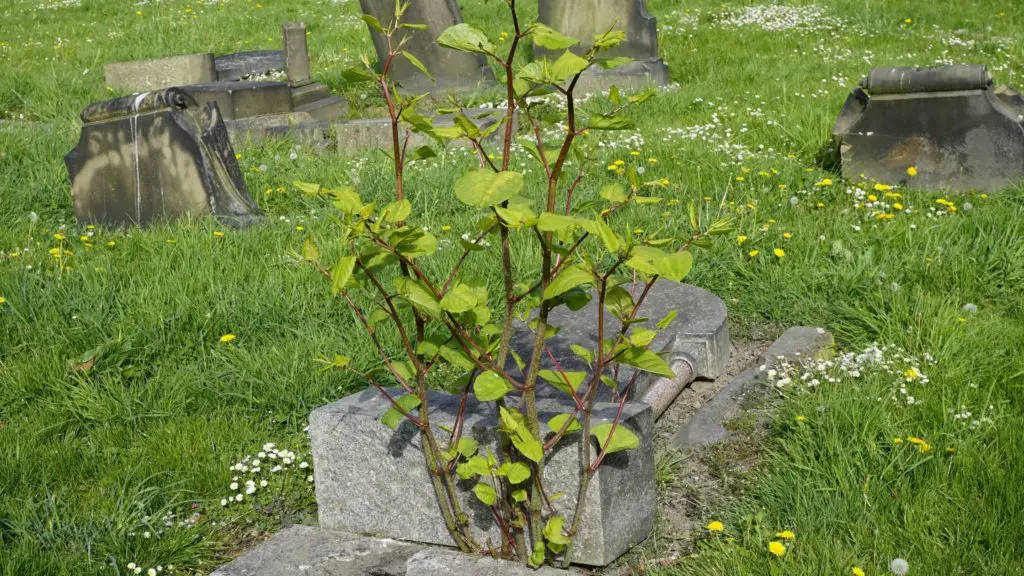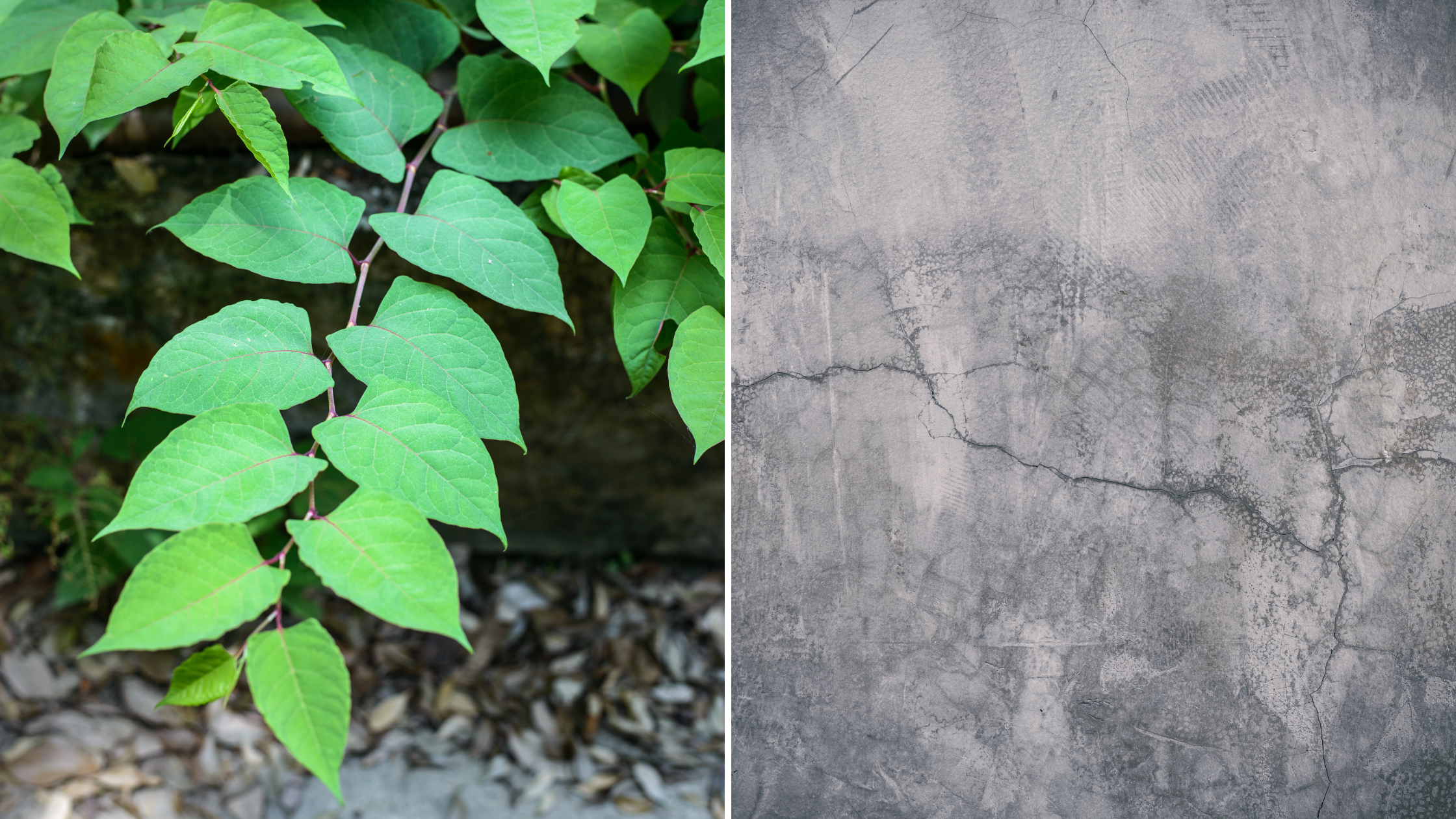Weeds are invasive at the best of times. They can work their way through the tiniest cracks. This is usually not a problem, but Japanese Knotweed is a bit different.
Japanese knotweed can be hugely disruptive, and can cause all sorts of problems for structures, but is it true that can knotweed grow through concrete? Here is everything that you need to know.
Can Knotweed Grow Through Concrete?
The simple answer is no, Japanese knotweed cannot grow through concrete. It is an opportunistic plant that exploits cracks, making it look like they grow through concrete. The only way you might see knotweed growing through concrete is if there is already a crack or fracture.

What Is Japanese Knotweed?
Japanese knotweed, also called Godzilla weed, is a part of the buckwheat family. The plant got introduced to the United States of America in the late 1800s, making it an invasive plant. While it is helpful because it is an erosion control plant, this weed grows rapidly and can quickly overtake other plants.
Japanese Knotweed is an upright plant that looks woody and shrubby, and the plant can grow up to 10-15 feet tall. The stems are hollow but smooth and stout. The leaves of this weed are broad and attached to the stem.
Why Do People Think Japanese Knotweed Grows Through Concrete?
Japanese knotweed takes advantage of small cracks, making it look like the plant can directly penetrate concrete and brick set paving. However, it will only exploit cracks. The plant grows rapidly and can naturally expand quickly, looking like it grows through nearby structures as well.
The weed is not strong. The plant root does not have the strength to break through surrounding concrete. Instead, it will go through structural weaknesses, like a crack or gap, if it has the chance.
However, that does not mean it is alright for Japanese knotweed to invade building materials. It can still cause major issues in the long term. So, DIY efforts may not be enough to solve the problem, especially if the knotweed keeps coming back.

Where Does Japanese Knotweed Grow?
Japanese knotweed can pretty much grow in almost any environment, which is why it can be found in the UK, Europe, the US and Asia. It only needs some moisture and light to thrive before it rapidly grows.
What Countries Is Japanese Knotweed Native to?
As you can guess from the name, Japanese knotweed is from Japan. Other countries got knotweed from Japan because they function as erosion control plants. Plus, it worked as an ornamental one. However, its presence and speedy growth quickly made it an invasive species.
Does Japanese Knotweed Grow Quickly?
Yes, Japanese knotweed grows quickly, and it can destroy native vegetation. In some cases, it can grow as much as 3-7 inches in a single day, spreading to as far as 23 feet in all directions. The roots expand to as deep as 9-10 feet, creating a large root network.
Of course, it will depend on the climate. Japanese knotweed can grow faster in the summer months. However, it is still dangerous to your garden and property if left untreated.
How Do You Get Rid of Japanese Knotweed?
There are many ways to get rid of Japanese knotweed from your garden or building materials. However, it is likely that you may have to try different strategies or repeat them throughout the year since the plant will grow rapidly. You may also call a professional.
Smothering is often one of the first strategies, and it is best done in the spring. You can use mulch, tarp, etc., to lay over the knotweed, creating a sealed surface to smother the plant. The darkness provides moisture which makes weeds thrive. However, it also blocks out light, killing the plant, and it benefits the soil conditions.
However, you may need to watch out for new growth during the smothering process. New shoots can appear over time, pushing the tarp or mulch up. You can simply walk over the new shoots to trample them.
Cutting is also important to do when the weed grows the most, so it is most effective during the summer. That way, the plant cannot photosynthesize. Remember to put the cuttings into a bag and throw them. Otherwise, they will grow again.
Another option that you can try alone or with the other methods is to dig up the Japanese knotweed. The idea is to dig wherever knotweed grows the most. You want to dig up the Japanese knotweed rhizome clumps, a part of the root system that grows more shoots. The rhizome clump root can spread to a foot wide or longer.
Finally, an herbicide may also be used, especially in the winter months to kill the weed. However, it can be dangerous for humans, kids and pets. Moreover, it is not safe for the environment, and it can harm many other plants.
If would be best to wear protection when you use weed killer, like gloves, a mask and goggles. However, a professional may be best for this job.
To Sum Up
If you are not aware, you may think Japanese knotweed can grow through concrete, but it cannot. The root barrier membranes and stems are not strong enough. However, it will take advantage of any crack or gap, so it can still cause problems.
Recommended Articles:
- Can You Pour a Concrete Slab Over Grass?
- Do I Need a Permit to Build a Concrete Patio?
- Recycled Glass in Concrete
- How to Finish a Concrete Slab
References:
- New York Invasive Species, ‘Japanese Knotweed’, http://nyis.info/invasive_species/japanese-knotweed/, Date Accessed – 8 August, 2021
- US Forest Service, ‘Invasive Plants’, https://www.fs.fed.us/wildflowers/invasives/index.shtml, Date Accessed – 8 August, 2021
- MIT News, ‘Understanding how plants use sunlight’, https://news.mit.edu/2018/mit-energy-initiative-better-understanding-how-plants-use-sunlight-1204, Date Accessed – 8 August, 2021
- PennState, ‘Glyphosate (Roundup): Understanding Risks to Human Health’, https://extension.psu.edu/glyphosate-roundup-understanding-risks-to-human-health#:~:text=All chemicals, including herbicides, are,the dose makes the poison“., Date Accessed – 8 August, 2021

